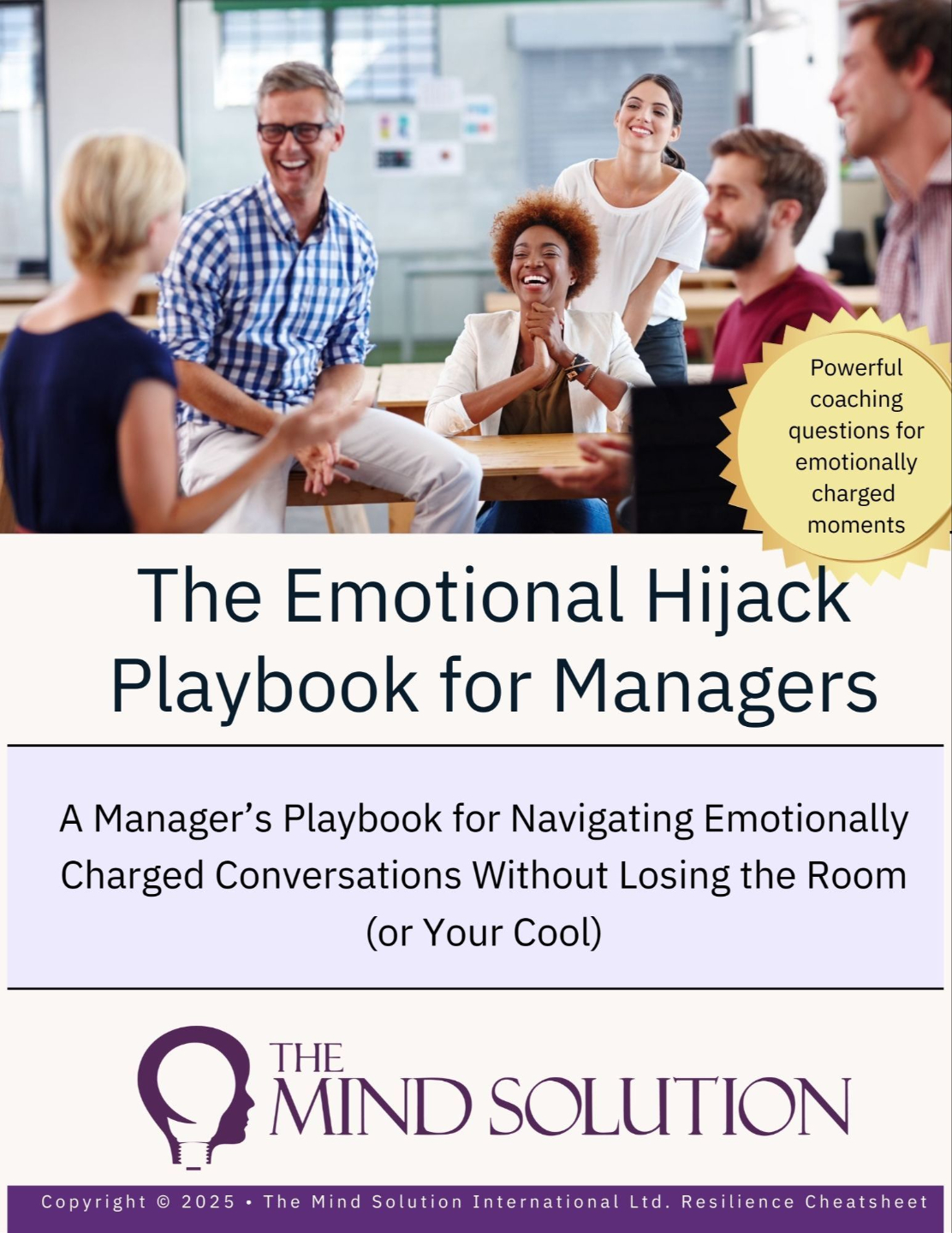How to Build Emotional Resilience at Work
Nov 03, 2025
One of my favourite subjects to teach is Emotional Resilience Training.
And while there’s still a strong demand for traditional resilience training within organisations, what I really love about emotional resilience is that it takes people beyond surface-level coping. It’s about how to live and navigate day to day from a state of being that is regulated, present, and self-aware.
The word resilience can mean many different things to different people. So let’s start by understanding what resilience means and the difference between resilience and emotional resilience.
The difference between resilience and emotional resilience
According to the Oxford English Dictionary, resilience is defined as “the capacity to withstand or recover quickly from difficulties; toughness.”
By contrast, emotional resilience refers to “the ability to adapt to stressful situations or crises without becoming overwhelmed, by maintaining emotional stability and perspective.”
While both definitions touch on strength and recovery, emotional resilience goes deeper. It’s not just about bouncing back from challenge; it’s about how we relate to our inner world as we do.
Emotional resilience is about staying connected to yourself, to presence, and to your own wisdom in the midst of change, challenge, and uncertainty.
Self-Awareness: The Foundation of Emotional Resilience
From my perspective, in order to navigate life with positive emotional resilience, we have to start with self-awareness.
If we’re not aware of the personal mind, of our habitual thinking and patterns of behaviour, and the thinking traps that trip us up and compromise our emotional resilience, then the depth to which we can experience true resilience will always be limited.
When you become aware of habitual thinking, it’s an invitation to remind yourself: I don’t need to go down that train of thought anymore. It’s a reminder that you can create a different loop.
Because what’s creating our experience is largely derived from thinking.
That awareness of these habitual, repetitive, automatic patterns of thought is critical, and it’s equally empowering. When you see thinking for what it is, automated neural circuitry in the brain, you begin to understand that it tells you nothing about reality.
Thinking isn’t personal. It’s just mental interference, like a passing storm in the mind.
And when you see that clearly, it’s liberating.
Because we can only ever see a situation from our current level of thinking. The moment we expand our awareness, we see life with far greater clarity.
The Power of Beliefs and Perceptual Filters
When you’ve thought something over and over again, those thought patterns create beliefs, and those beliefs shape your experience.
Beliefs act like filters that determine how you interpret life.
And what’s wonderfully liberating is when we create space to explore the beliefs we’ve been innocently holding onto about ourselves, others, and the world around us, and begin to question them.
Many people live through belief systems that no longer serve them.
In the context of resilience, these might sound like:
-
“It’s not safe to be vulnerable.”
-
“Emotion is a sign of weakness.”
-
“Men shouldn’t cry.”
-
“I can only rely on myself.”
-
“It’s not safe to trust other people.”
All of these beliefs were formed as a result of early experiences, and they’re quietly running the infrastructure of the brain.
The subconscious mind takes in around 11 million bits of data per second, while the conscious mind processes only 50 to 100 bits per second. It’s filtering what rises into awareness based on those deep, unconscious beliefs.
When we stop to question those assumptions, we expand our consciousness and expanding our awareness is crucial for emotional resilience.
Emotional resilience grows naturally when we have awareness of what’s really happening, when we are stable in both mind and body. And that stability comes through emotional regulation.
Regulating the Nervous System
So many people associate stress or burnout with their job or circumstances. But what’s often missing is the awareness that they’re not regulating their emotions daily.
They’re operating on autopilot from a dysregulated nervous system.
A simple way of looking at this is that you wouldn’t expect a car to get from A to B without the right resourcessuch as fuel, oil, air pressure, and water.
The human body is the same. It needs the right internal conditions to get you through the day.
As I teach in emotional resilience training, there are countless ways to regulate the nervous system, and when we do, we don’t have to reach for resilience. We simply are resilient.
When you’re grounded, present, and connected to your natural state of being, emotional resilience becomes effortless.
Emotion, after all, is simply energy in motion, sensations within the body.
But in a hyper state of emotional arousal, the mind will attach meaning to those sensations. And when we continually flood the body with the same chemical patterns, we can even find ourselves addicted to certain emotional states.
Emotional Hijacking and the Role of the Ego
Without awareness and understanding of the mind–body connection, it’s easy to experience emotional hijacking where emotion takes over reason and clarity.
Yet emotions are a wonderful thing. They act as an inner sat-nav, showing us where our focus of attention is.
When we can sit with an emotion and get curious, asking “What am I making this mean?” or “Where is my focus right now?” we expand our awareness.
We begin to see things as they really are, not how we think they are.
And for me, emotional resilience training wouldn’t be complete without understanding the ego.
The ego experiences life through fear, separation, and contraction. Any thinking that feels heavy or pressured is the ego at work.
The paradox of the ego is that it can never be satisfied. It craves change, yet resists it. What it truly wants - love, happiness, belonging - it can never have, because to experience those things, the ego itself must dissolve.
It’s why, when people begin creating positive change, they often feel great at first and then hit a wall. It can feel like going backwards. But it’s simply the ego trying to pull them back to what’s familiar.
We can’t teach emotional resilience without understanding this inner infrastructure, the interplay of thought, feeling, nervous system, and ego.
Returning to Your Natural State of Resilience
The personal mind operates from memory and conditioning. It has no awareness of what’s ahead.
When the ego senses change, it tries to protect us with fear.
Many people believe they need their life to look a certain way before they can feel emotionally resilient. I’ll relax when this project is finished. I’ll feel calm once this deadline is done.
But that’s a misunderstanding of where feelings come from.
The moment you believe your emotions depend on external conditions, you lose access to the resilience that’s already within you.
Everything you want to feel calm, safe, joy, peace, and belonging exists here and now.
So it’s not about creating those emotions. It’s about identifying what’s taking you away from your natural state.
What are the patterns of thought, emotional responses, or behaviours that are getting in the way of your innate resilience?
When you see those clearly, you come home to what was never missing: your natural capacity for wellbeing and balance.
Build Emotional Resilience Within Your Organisation
If you’d like to explore how emotional resilience training can support your HR leaders and teams, helping them stay grounded, clear, and emotionally intelligent no matter what they’re navigating, you can book a call hereto talk about bringing emotional resilience into your organisation.
Because emotional resilience isn’t something you build, it’s something you return to.
The Emotional Hijack Playbook For Managers
A Manager’s Free Resource for Navigating Emotionally Charged Conversations Without Losing the Room (or Your Cool).
Perfect to use in your next one-to-one.






